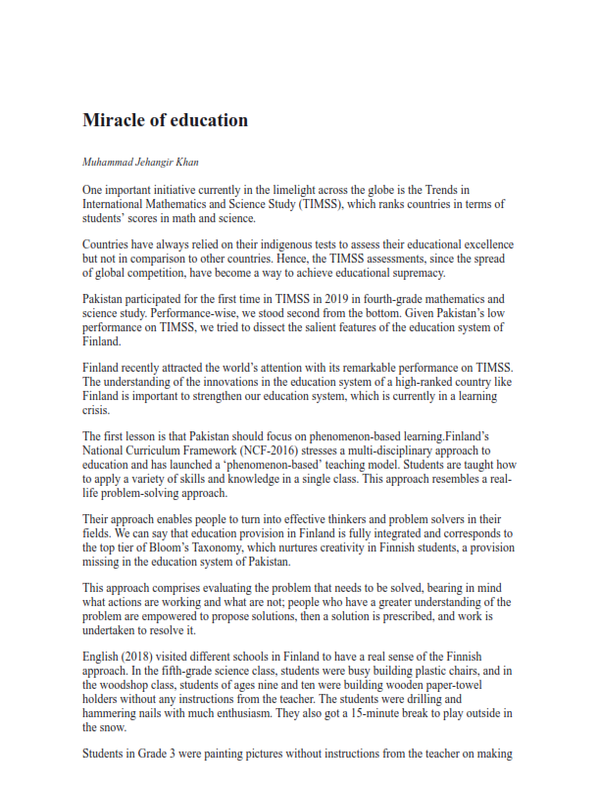
Pakistan Institute of Development Economics
- Home
Our Portals
MenuMenuMenuMenuMenuMenuMenu - ResearchMenuMenuMenuMenuMenuMenuMenu
- Discourse
- The PDR
- Our Researchers
- Academics
- Degree Verification
- Thesis Portal
- Our Portals
Miracle of education
One important initiative currently in the limelight across the globe is the Trends in International Mathematics and Science Study (TIMSS), which ranks countries in terms of students’ scores in math and science.
Countries have always relied on their indigenous tests to assess their educational excellence but not in comparison to other countries. Hence, the TIMSS assessments, since the spread of global competition, have become a way to achieve educational supremacy.
Pakistan participated for the first time in TIMSS in 2019 in fourth-grade mathematics and science study. Performance-wise, we stood second from the bottom. Given Pakistan’s low performance on TIMSS, we tried to dissect the salient features of the education system of Finland.
Finland recently attracted the world’s attention with its remarkable performance on TIMSS. The understanding of the innovations in the education system of a high-ranked country like Finland is important to strengthen our education system, which is currently in a learning crisis.
The first lesson is that Pakistan should focus on phenomenon-based learning.Finland’s National Curriculum Framework (NCF-2016) stresses a multi-disciplinary approach to education and has launched a ‘phenomenon-based’ teaching model. Students are taught how to apply a variety of skills and knowledge in a single class. This approach resembles a real-life problem-solving approach.
Their approach enables people to turn into effective thinkers and problem solvers in their fields. We can say that education provision in Finland is fully integrated and corresponds to the top tier of Bloom’s Taxonomy, which nurtures creativity in Finnish students, a provision missing in the education system of Pakistan.
This approach comprises evaluating the problem that needs to be solved, bearing in mind what actions are working and what are not; people who have a greater understanding of the problem are empowered to propose solutions, then a solution is prescribed, and work is undertaken to resolve it.
English (2018) visited different schools in Finland to have a real sense of the Finnish approach. In the fifth-grade science class, students were busy building plastic chairs, and in the woodshop class, students of ages nine and ten were building wooden paper-towel holders without any instructions from the teacher. The students were drilling and hammering nails with much enthusiasm. They also got a 15-minute break to play outside in the snow.
Students in Grade 3 were painting pictures without instructions from the teacher on making brown paint. Teachers refrained from giving directions or steps to follow in all classes while solving a problem. The students knew what paper-towel holders were, so the goal was to figure out how to design and develop them. The teachers gave students certain problems to solve and then stepped back and helped only when needed. This approach was applied in the science and art classes, in secondary schools, and even in universities.
Our second lesson is that Pakistan should decentralize its public education delivery. In Finland, teachers independently decide how to educate students. Principals are authorized to decide about teachers; municipalities decide how to support schools, and the national board decides how to support the entire education system. In contrast, the education system in Pakistan uses a top-down approach to problem-solving where decisions about learning and teaching are made by those who themselves are not teachers or have not worked directly with students.
The core curriculum in Finland is an objective but not a standard. Teachers are free to set learning targets to optimize learning for each child. For instance, if the target is to grasp the idea of an ecosystem, there could be multiple ways to learn about it. The objective is to nurture more creativity in teachers to adjust to individual learning needs. This framework is different from what we have in Pakistan, where every child has to read the same topic and answer the same questions on it to assess how many questions they have answered correctly.
Besides, education reform has been seriously driven since the 1970s in Finland. It has relied on the ensuring competency and professionalism of teachers, giving more importance to early childhood education, and on decentralized administration to give local schools the full authority to address local needs.
The deficits in Pakistan’s education system outlined above suggest several implications for education policy and reforms. First, Pakistan must decentralize and declare complete autonomy of its schools. This reform will enhance competition among schools in a neighborhood and inter-province competition among schools.
Schools in each neighbourhood must be judged and ranked on selected performance parameters (student scores, etc, conducted by an international accreditation agency, not BISEs). Schools that outperform others must be incentivized with extra benefits such as performance bonuses and promotions. This reform must be introduced at a small scale, perhaps in schools in Islamabad, and gradually scale up to other regions and provinces.
Second, we must map our curriculum with Bloom’s Taxonomy. Currently, Pakistan’s curriculum only touches the lower tiers of Bloom’s, so there is little scope to nurture students’ creative skills at the grassroots level.
With no concern for creative skills in our curriculum, we have failed in multiple indicators on the global front. Out of the 132 economies, Pakistan ranks 99th in the 2021 Global Innovation Index; Finland ranks seventh. A country’s education system speaks louder than anything else.
The writer is an assistant professor at the Pakistan Institute of Development Economics (PIDE) and can be reached at: [email protected]



